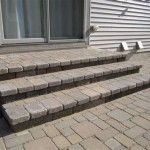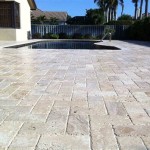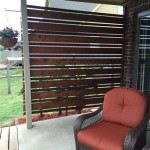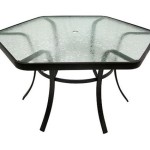Should You Seal a Cement Patio?
A cement patio offers an attractive and functional outdoor space, extending living areas into the landscape. However, like any construction material exposed to the elements, cement is susceptible to damage and deterioration over time. Sealing a cement patio is a common practice intended to protect the surface and prolong its lifespan. The decision to seal a cement patio involves weighing the benefits against the potential drawbacks, and understanding the specific needs of the installation.
Unsealed cement is porous, meaning it contains microscopic pores that allow liquids and gases to penetrate its surface. This porosity can lead to a variety of problems, including staining, cracking, spalling (surface flaking), and the growth of mold and mildew. Environmental factors, such as freeze-thaw cycles, exposure to ultraviolet (UV) radiation, and chemical interactions with de-icing salts or fertilizers, can exacerbate these issues. Sealing acts as a barrier, mitigating the harmful effects of these elements.
Determining whether to seal a cement patio requires careful consideration of several factors, including the patio's location, exposure to the elements, the type of cement used, intended use of the patio, and aesthetic preferences. This article explores the advantages and disadvantages of sealing, different types of sealers, and alternative strategies for maintaining a cement patio.
Key Point 1: Advantages of Sealing a Cement Patio
Sealing a cement patio presents several compelling advantages, primarily related to protection and longevity. These benefits include enhanced durability, improved aesthetics, reduced maintenance, and protection from specific environmental threats.
One of the most significant advantages is enhanced durability. Sealers create a protective barrier that prevents water and other liquids from penetrating the cement. This is particularly critical in regions with freezing temperatures, where water intrusion can lead to freeze-thaw damage. When water penetrates the cement and freezes, it expands, creating internal pressure that can cause cracks and surface deterioration. A sealer minimizes water absorption, thereby reducing the risk of these problems.
Sealers also improve the aesthetic appeal of a cement patio. Unsealed cement can become stained by spills, dirt, and organic matter. Sealers prevent these substances from penetrating the surface, making it easier to clean and maintain a pristine appearance. Some sealers are designed to enhance the natural color of the cement or provide a glossy finish, further improving its aesthetic qualities. The ability to resist staining from common outdoor contaminants, like oil leaks from grills or plant debris, keeps the patio looking newer for longer.
Reduced maintenance is another key benefit of sealing a cement patio. The protective barrier created by the sealer makes the surface easier to clean and reduces the need for frequent pressure washing or scrubbing. By preventing dirt and grime from embedding in the pores of the cement, a sealer simplifies routine cleaning tasks. Regular sweeping and occasional rinsing with a garden hose can often be sufficient to keep a sealed patio looking its best, saving time and effort on maintenance.
Certain sealers offer protection against specific environmental threats. For example, some sealers are formulated to resist the effects of UV radiation, which can cause the cement to fade or discolor over time. Others are designed to withstand the corrosive effects of de-icing salts, which are commonly used in colder climates to melt ice and snow. These specialized sealers can significantly extend the lifespan of a cement patio in areas where these threats are prevalent. The ability to resist algae and mildew growth, particularly in shaded areas, further reduces the need for harsh cleaning chemicals and preserves the surface integrity.
Key Point 2: Disadvantages of Sealing a Cement Patio
While sealing a cement patio offers numerous benefits, there are also potential drawbacks to consider. These include the cost of materials and labor, the need for periodic reapplication, potential for moisture trapping, and the possibility of altering the appearance or texture of the cement.
The cost of materials and labor can be a significant factor. Sealers vary in price, depending on their type, quality, and coverage area. Professional application can add to the overall expense. Although sealing can prevent costly repairs in the long run, the initial investment may be a deterrent for budget-conscious homeowners. The expense associated with surface preparation, such as cleaning and patching cracks, should also be factored into the overall cost.
Periodic reapplication is necessary to maintain the effectiveness of a sealer. Over time, sealers can wear down due to exposure to the elements and foot traffic. The frequency of reapplication depends on the type of sealer used and the environmental conditions. Some sealers may need to be reapplied every one to two years, while others can last longer. Keeping track of when reapplication is due and ensuring the surface is properly prepared before resealing requires ongoing effort and expense.
Moisture trapping is a potential concern with some types of sealers. If moisture is already present within the cement before sealing, or if water penetrates through cracks or joints, the sealer can trap the moisture inside. This can lead to efflorescence (a white, powdery deposit), mold growth, and accelerated deterioration of the cement. Selecting a breathable sealer that allows moisture vapor to escape can help mitigate this risk. Ensuring proper drainage around the patio is also crucial to prevent water from accumulating and seeping into the cement.
Sealers can alter the appearance or texture of the cement. Some sealers create a glossy finish, which may not be desirable for all patios. Others can darken the cement or change its color. It is important to choose a sealer that complements the aesthetic of the patio and to test the sealer on a small, inconspicuous area before applying it to the entire surface. Certain sealers may also make the surface more slippery when wet, posing a safety hazard. Opting for a sealer with a non-slip additive can help address this concern.
Key Point 3: Types of Cement Sealers and Alternatives
Selecting the appropriate sealer is crucial for achieving the desired results and avoiding potential problems. Different types of sealers offer varying levels of protection, durability, and aesthetic effects. Furthermore, alternative strategies for maintaining a cement patio can be employed instead of or in conjunction with sealing.
Acrylic sealers are a common and relatively inexpensive option. They provide good protection against water and staining, and are easy to apply. However, acrylic sealers are less durable than other types and may require more frequent reapplication. They are typically water-based, making them environmentally friendly and easy to clean up. Acrylic sealers are well-suited for patios that receive moderate use and are not exposed to harsh environmental conditions.
Epoxy sealers offer superior durability and chemical resistance. They form a hard, protective coating that is resistant to scratches, stains, and chemicals. Epoxy sealers are often used in high-traffic areas and industrial settings. However, they can be more difficult to apply and may require professional installation. Epoxy sealers are typically two-part systems that must be mixed carefully before application. They can also be more expensive than other types of sealers.
Penetrating sealers, also known as silane or siloxane sealers, penetrate the cement surface and react chemically to create a water-repellent barrier. These sealers do not form a surface film, so they do not alter the appearance or texture of the cement. They are breathable, allowing moisture vapor to escape, which can help prevent moisture trapping. Penetrating sealers are a good option for patios where maintaining the natural look of the cement is a priority.
Polyurethane sealers offer a combination of durability, chemical resistance, and aesthetic appeal. They form a tough, flexible coating that is resistant to abrasion and UV radiation. Polyurethane sealers can be used to create a glossy or matte finish, depending on the specific formulation. They are a good option for patios that are exposed to heavy use and harsh environmental conditions. However, polyurethane sealers can be more expensive than other types of sealers and may require professional installation.
Alternatives to sealing include regular cleaning and maintenance. Sweeping the patio regularly to remove dirt and debris can help prevent staining and surface deterioration. Pressure washing can be used to remove stubborn stains and grime, but it is important to use a low-pressure setting to avoid damaging the cement. Applying a concrete densifier can also help to harden the surface and reduce its porosity. Concrete densifiers react chemically with the cement to create a stronger, more durable surface. Properly sloping the patio to ensure adequate drainage is also crucial for preventing water from accumulating and causing damage.

Why You Should Seal Your Concrete Driveway Or Patio Gleam Team

Concrete Sealing Types And Methods Step By Instructions

How Often Should You Reseal Your Concrete Increte Of Houston

Penetrating Vs Surface Concrete Sealers Which Is Best

Choosing The Right Concrete Sealer For Job Decor

How Much Does Sealer Cost

Concrete Stain And Sealer Patio Makeover Exchange

7 Steps To Sealing Concrete Like A Pro Expert How Guide Network

How To Re Seal A Stained Concrete Patio

Wet Look Concrete Sealer What You Need To Know
Related Posts








